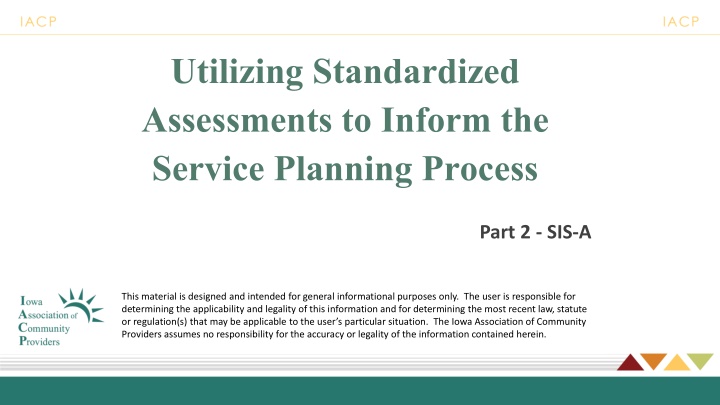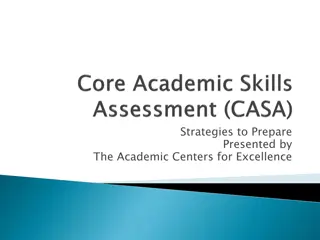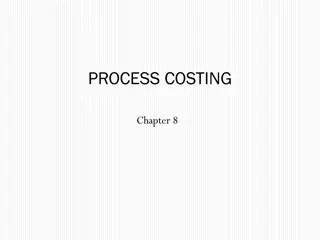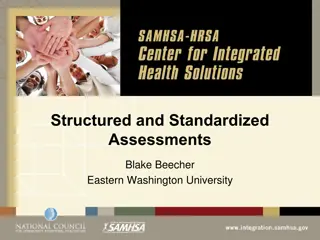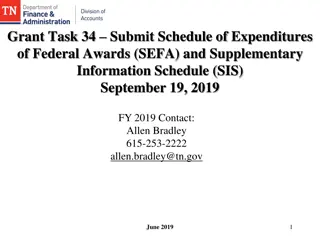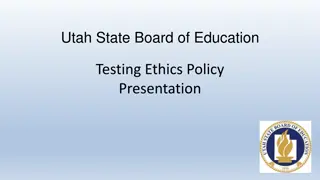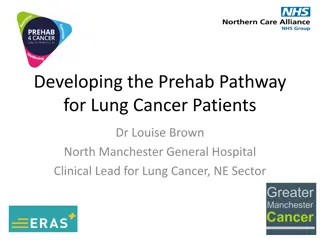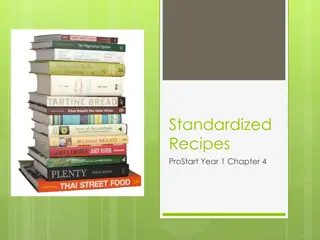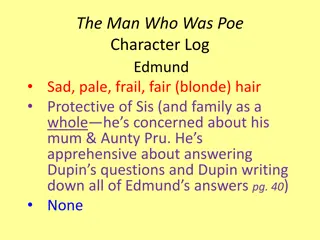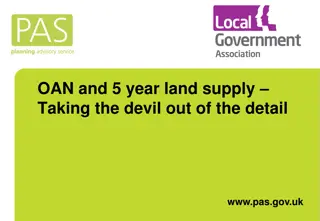Utilizing Standardized Assessments to Enhance Service Planning Process - SIS-A
The Supports Intensity Scale-Adult Version (SIS-A) focuses on identifying necessary supports for success rather than limitations. It provides reliable measurements of individual support needs in various settings. The tool aids planning teams in creating personalized supports to improve quality of life. Overcoming initial barriers and incorporating essential elements lead to successful life planning using SIS-A.
Download Presentation

Please find below an Image/Link to download the presentation.
The content on the website is provided AS IS for your information and personal use only. It may not be sold, licensed, or shared on other websites without obtaining consent from the author.If you encounter any issues during the download, it is possible that the publisher has removed the file from their server.
You are allowed to download the files provided on this website for personal or commercial use, subject to the condition that they are used lawfully. All files are the property of their respective owners.
The content on the website is provided AS IS for your information and personal use only. It may not be sold, licensed, or shared on other websites without obtaining consent from the author.
E N D
Presentation Transcript
Utilizing Standardized Assessments to Inform the Service Planning Process Part 2 - SIS-A This material is designed and intended for general informational purposes only. The user is responsible for determining the applicability and legality of this information and for determining the most recent law, statute or regulation(s) that may be applicable to the user s particular situation. The Iowa Association of Community Providers assumes no responsibility for the accuracy or legality of the information contained herein.
Supports Intensity Scale-Adult Version (SIS-A) Objectives of the SIS-A: Published by AAIDD in 2004 with the original title of Supports Intensity Scale to move the focus of planning away from can t do to identifying supports necessary to succeed. Reliable & valid measurements of individual support needs. The data represents supports necessary in general settings & activities which are typical to most people. A resource for planning teams to utilize in creating meaningful personalized supports to enhance quality of life regardless of disability was printed in 2017. Person-Centered Planning With the Supports Intensity Scale Adult Version. A Guide For Planning Teams serves as the primary resource for the presentation.
Supports Intensity Scale-Adult Version (SIS-A) Regardless of the connection to Tier Assignment this resource has a very meaningful purpose in the service planning process!
Initial Barriers to Service Planning Truly including & knowing the individual It is not a simple task to establish & align personalized supports Time it takes a lot to put together a good plan. Thinking outside the box for solutions to everyday challenges. Team members wanting different outcomes.
Essential Elements of Successful Planning Start with a good look at the BIG PICTURE The plan addresses a LIFE not just the next 12 months. Long term planning conversations to avoid crisis decision making. Identify Success to Celebrate & Prioritize Change Discuss the aspects going well & how to maintain the success. Discuss the aspects of change through priority Be Purposeful rather than RUSH to Finish This is LIFE planning NOT event planning The Outcome of Planning is an Action Plan Results Change a Life for the Better
Understanding & Using the Support Needs Profile Activities Subscale: Home Living Community Living Lifelong Learning Employment Health & Safety Social *Don t forget the impact of Medical Conditions, Health Care & Behavioral Challenges on support needs.
Medical Conditions & Health Care A significant influence to all types of behavior comes from underlying physical and mental health along with sensory conditions. A clear understanding of these issues and impact of the condition on the person has a tremendous influence in supports provided. List each medical condition with the corresponding description of the support need required. List specifics related to any the following: Sensory issues Gastrointestinal issues and/or food allergies Mental Health issues Thompson et al (2017). Person-Centered Planning with Supports Intensity Scale- Adult Version A Guide for Planning Teams. Washington, DC: American Association of Intellectual & Developmental Disabilities
Medical Conditions & Health Care List the medications prescribed with any side effects and/or support needs of the medication. List the doctor(s) working with the individual. Are the necessary medical professionals available to the individual? List each medical professional and/or medical services needed but not currently available to treat the individual. List support needs specific to managing medical care and scheduling appointments. Thompson et al (2017). Person-Centered Planning with Supports Intensity Scale- Adult Version A Guide for Planning Teams. Washington, DC: American Association of Intellectual & Developmental Disabilities
Challenging Behaviors In many cases Challenging Behaviors serve as a function of communication. Accurately identifying the purpose & meaning of the behavior is essential in developing most appropriate support: List all challenging behavior with the corresponding description of the support need required. List a description of behaviors which interfere with successful social functioning with corresponding support needs. List any restrictive, repetitive patterns of behavior with corresponding support needs. List any challenging behaviors associated with communication difficulties (receptive or expressive) with corresponding support needs. Has a functional assessment been completed? List the results/recommendations. List all additional supports necessary for planning, scheduling and managing behavioral supports Thompson et al (2017). Person-Centered Planning with Supports Intensity Scale- Adult Version A Guide for Planning Teams. Washington, DC: American Association of Intellectual & Developmental Disabilities
Home Living The ability to have and maintain a home is an essential component of community living. A HOME is an apartment, house or shared living environment which fosters feelings of safety and comfort. It promotes opportunities for basic daily activities such as preparing food, grooming & hygiene, cleaning, home maintenance, and many other tasks. List the individual s current living environment followed by the preferred living arrangements (it might be the same). List the discrepancies between the two and highlight the desired. Prioritize the necessary changes. Thompson et al (2017). Person-Centered Planning with Supports Intensity Scale- Adult Version A Guide for Planning Teams. Washington, DC: American Association of Intellectual & Developmental Disabilities
Home Living: SIS-A Subscale Activities Type Frequency Daily Support Time Addressing the Support Need (who, what & when) Using the toilet Dressing Bathing, personal hygiene & grooming Preparing Food Eating Food Housekeeping & cleaning Taking care of clothing & laundry Operating home appliances & electronics Thompson et al (2017). Person-Centered Planning with Supports Intensity Scale- Adult Version A Guide for Planning Teams. Washington, DC: American Association of Intellectual & Developmental Disabilities
Home Living- Short- & Long-Term Support Needs Short-Term: 6 Months from Today Long-Term: (Identify a Target Date) Where will the individual live? With whom will the individual live? What supports are needed? What steps will be taken, by whom to meet the target? Thompson et al (2017). Person-Centered Planning with Supports Intensity Scale- Adult Version A Guide for Planning Teams. Washington, DC: American Association of Intellectual & Developmental Disabilities
Community Living Community living where an individual chooses to live, learn, work and recreate! The opportunity for an individual to be physically present, develop relationships, participate in social interests, and access community resources regardless of disability. List the individual s current participation in community living activities & the degree of participation and then the preferred activities. List the discrepancies between the two and highlight the desired. Prioritize the necessary changes. Thompson et al (2017). Person-Centered Planning with Supports Intensity Scale- Adult Version A Guide for Planning Teams. Washington, DC: American Association of Intellectual & Developmental Disabilities
Community Living SIS-A Subscale Community Living Activities Type Frequency Daily Support Time Addressing the Support Need (who, what & when) Going to visit friends & family Shopping & purchasing goods & services Interacting with community members Using public services in the community Accessing public buildings & settings Getting around in the community (transportation) Participating in recreation/leisure activities in community settings Participating in preferred community activities Thompson et al (2017). Person-Centered Planning with Supports Intensity Scale- Adult Version A Guide for Planning Teams. Washington, DC: American Association of Intellectual & Developmental Disabilities
Community Living Short- & Long-Term Support Needs Short-Term: 6 Months from Today Long-Term: (Identify a Target Date) In what types of community activities will the individual be participating? With whom will the individual participating? What supports are needed? What steps will be taken, by whom to meet the target? Thompson et al (2017). Person-Centered Planning with Supports Intensity Scale- Adult Version A Guide for Planning Teams. Washington, DC: American Association of Intellectual & Developmental Disabilities
Life Long Learning Humans are lifelong learners. We are all in a constant state of learning from exposure to new environments and interactions. List the current lifelong learning activities and then the preferred ones. List the discrepancies between the two and highlight the desired. Prioritize the necessary changes. Thompson et al (2017). Person-Centered Planning with Supports Intensity Scale- Adult Version A Guide for Planning Teams. Washington, DC: American Association of Intellectual & Developmental Disabilities
Lifelong Learning SIS-A Subscale Lifelong Learning Activities Type Frequency Daily Support Time Addressing the Support Need (who, what & when) Learning & using problem-solving strategies Learning functional academics (reading signs, counting change etc.) Learning self-determination skills Learning self-management skills Participating in training/educational decisions Accessing training/educational settings Interacting with others in learning activities Using technology for learning Thompson et al (2017). Person-Centered Planning with Supports Intensity Scale- Adult Version A Guide for Planning Teams. Washington, DC: American Association of Intellectual & Developmental Disabilities
Lifelong Learning Short- & Long-Term Support Needs Short-Term: 6 Months from Today Long-Term: (Identify a Target Date) What specific lifelong learning goals are most important to the individual? Where and with whom will the person be pursuing his/her lifelong learning goals? What supports are needed? What steps will be taken, by whom to meet the target? Thompson et al (2017). Person-Centered Planning with Supports Intensity Scale- Adult Version A Guide for Planning Teams. Washington, DC: American Association of Intellectual & Developmental Disabilities
Employment Jobs provide people with a purpose in life. Jobs offer motivation to participate and contribute in a meaningful way. A paycheck provides opportunities otherwise not available. List the current work status and then the preferred employment status. List the discrepancies between the two and highlight the desired. Prioritize the necessary changes. Thompson et al (2017). Person-Centered Planning with Supports Intensity Scale- Adult Version A Guide for Planning Teams. Washington, DC: American Association of Intellectual & Developmental Disabilities
Employment SIS-A Subscale Employment Activities Type Frequency Daily Support Time Addressing the Support Need (who, what & when) Learning and using specific job skills Accessing/receiving job/task accommodations Interacting with coworkers Interacting with supervisors/job coaches Completing work-related tasks with acceptable speed Completing work-related tasks with acceptable quality Changing job assignments Seeking information & assistance from an employer Thompson et al (2017). Person-Centered Planning with Supports Intensity Scale- Adult Version A Guide for Planning Teams. Washington, DC: American Association of Intellectual & Developmental Disabilities
Employment Short- & Long-Term Support Needs Short-Term: 6 Months from Today Long-Term: (Identify a Target Date) What job does the individual want to be a contributing member of his/her community? Where and with whom will the individual be working? What supports are needed? What steps will be taken, by whom to meet the target? Thompson et al (2017). Person-Centered Planning with Supports Intensity Scale- Adult Version A Guide for Planning Teams. Washington, DC: American Association of Intellectual & Developmental Disabilities
Health and Safety These measures are critical to quality-of-life. These are challenges with judgment and problem solving. People need to be able to recognize emergencies and how to receive help. List the current health and safety needs along with vulnerabilities and then list the preferred ways to manage these needs. List the discrepancies between the two and highlight the desired. Prioritize the necessary changes. Thompson et al (2017). Person-Centered Planning with Supports Intensity Scale- Adult Version A Guide for Planning Teams. Washington, DC: American Association of Intellectual & Developmental Disabilities
Health & Safety SIS-A Subscale Health & Safety Activities Type Frequency Daily Support Time Addressing the Support Need (who, what & when) Taking medications Ambulating & moving about Avoiding hazards Obtaining health care services Learning how to access emergency services Maintaining a nutritious diet Maintaining physical health & fitness Maintaining emotional well- being Thompson et al (2017). Person-Centered Planning with Supports Intensity Scale- Adult Version A Guide for Planning Teams. Washington, DC: American Association of Intellectual & Developmental Disabilities
Health & Safety Short- & Long-Term Support Needs Short-Term: 6 Months from Today Long-Term: (Identify a Target Date) What are the most critical health & safety needs for this individual? What supports are needed to keep the individual healthy & safe? What steps will be taken, by whom to meet the target? Thompson et al (2017). Person-Centered Planning with Supports Intensity Scale- Adult Version A Guide for Planning Teams. Washington, DC: American Association of Intellectual & Developmental Disabilities
Social Activities The opportunity engage in social activities with friends is an quality of life measurement. Friends and social opportunities enhance quality of life for all. List the current social activities and then the preferred social activities. List the discrepancies between the two and highlight the desired. Prioritize the necessary changes. Thompson et al (2017). Person-Centered Planning with Supports Intensity Scale- Adult Version A Guide for Planning Teams. Washington, DC: American Association of Intellectual & Developmental Disabilities
Social Activities SIS-A Subscale Social Activity Activities Type Frequency Daily Support Time Addressing the Support Need (who, what & when) Using appropriate social skills Participating in recreation/leisure activities with others Socializing outside the household Making & keeping friends Engaging in loving & intimate relationships Socializing within the household Communicating with others about personal needs Engaging in volunteer work Thompson et al (2017). Person-Centered Planning with Supports Intensity Scale- Adult Version A Guide for Planning Teams. Washington, DC: American Association of Intellectual & Developmental Disabilities
Social Activities Short- & Long-Term Support Needs Short-Term: 6 Months from Today Long-Term: (Identify a Target Date) What situations and with what people are most valued & important for the individual to successfully socialize & interact? What supports are needed? What steps will be taken, by whom to meet the target? Thompson et al (2017). Person-Centered Planning with Supports Intensity Scale- Adult Version A Guide for Planning Teams. Washington, DC: American Association of Intellectual & Developmental Disabilities
Advocacy Self-determination & self-advocacy dignity, respect and opportunities afforded regardless of disability contributes to a better quality of life. List the current advocacy activities and then the preferred activities. List the discrepancies between the two and highlight the desired. Prioritize the necessary changes. Thompson et al (2017). Person-Centered Planning with Supports Intensity Scale- Adult Version A Guide for Planning Teams. Washington, DC: American Association of Intellectual & Developmental Disabilities
Advocacy SIS-A Subscale Protection & Advocacy Activities Type Frequency Daily Support Time Addressing the Support Need (who, what & when) Advocating for self Making choices & decisions Protecting self from exploitation Exercising legal/civic responsibilities Belonging to & participating in self-advocacy/support organizations Obtaining legal services Managing money & personal finances Advocating for others Thompson et al (2017). Person-Centered Planning with Supports Intensity Scale- Adult Version A Guide for Planning Teams. Washington, DC: American Association of Intellectual & Developmental Disabilities
Advocacy Short- & Long-Term Support Needs Short-Term: 6 Months from Today Long-Term: (Identify a Target Date) What situations and with what people are most important for the individual to successfully advocate for self & others? What supports are needed? What steps will be taken, by whom to meet the target? Thompson et al (2017). Person-Centered Planning with Supports Intensity Scale- Adult Version A Guide for Planning Teams. Washington, DC: American Association of Intellectual & Developmental Disabilities
Support Needs Crossing Domains Now it s time to identify supports living in two different domains. The team engaging in serious analysis at this point in the process is necessary. Some common examples: Supports to understand social boundaries Supports when faced with unexpected activities and new situations Supports in decision making Supports in self-regulations
Review All the Information Collected Create a description of main support need in each of the categories listed below. Home Living Community Living Lifelong Learning Employment Health & Safety Social Medical Conditions Health Care Behavioral Challenges Thompson et al (2017). Person-Centered Planning with Supports Intensity Scale- Adult Version A Guide for Planning Teams. Washington, DC: American Association of Intellectual & Developmental Disabilities
Essential Supports Needs Using the descriptions just created, the next step is to identify all potential sources to address the support needs along with how the supports will actually work What will people do? What technologies will be utilized? What strategies will be put into place? Thompson et al (2017). Person-Centered Planning with Supports Intensity Scale- Adult Version A Guide for Planning Teams. Washington, DC: American Association of Intellectual & Developmental Disabilities
Putting It Together to Inform Plan Writing Determine the priorities remember not everything is a priority. Which address essential basic human needs? What are the non-negotiable priority given the impact on health and safety? Which impact quality of life desires? This is where and when listening to the perspectives of all team members is vitally important to ensure the hopes, dreams and aspirations of the individual serve as the foundation of the plan to be written. Thompson et al (2017). Person-Centered Planning with Supports Intensity Scale- Adult Version A Guide for Planning Teams. Washington, DC: American Association of Intellectual & Developmental Disabilities
The Well What If The process for using the SIS-A shared is best practice as researched and shared by AAIDD. Committing your organization to engage in this process is of course your decision; however using the SIS-A to inform the plan supports the team with meeting medical necessity on the way to providing person-centered services. If the team doesn t explore the domains, the plan isn t as likely to have a long-term impact on quality of life through community experiences. Thompson et al (2017). Person-Centered Planning with Supports Intensity Scale- Adult Version A Guide for Planning Teams. Washington, DC: American Association of Intellectual & Developmental Disabilities
Questions The planning guide can be purchased at www.aaidd.org
